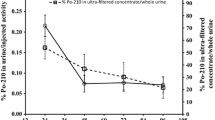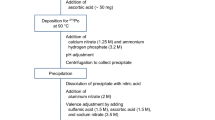Abstract
Evaluation of yttrium exposure in biological samples has not been fully examined. To evaluate yttrium nephrotoxicity, yttrium chloride was orally administered to male Wistar rats and the urine volume (UV) and N-acetyl-β-d-glucosaminidase (NAG) and creatinine excretion (Crt) were measured in 24-h urine samples. The urinary yttrium concentration and excretion rate were determined by inductively coupled plasma-argon emission spectrometry (ICP-AES). Large significant decreases of UV (>30%) and Crt (>10%) were observed at yttrium doses of 58.3–116.7 mg per rat, but no significant NAG changes was observed. This response pattern shows that a high yttrium dosage alters glomerular function rather than the proximal convoluted tubules. A urinary yttrium excretion rate of 0.216% and good dose-dependent urinary excretion (r=0.77) were confirmed. These results suggest that urinary yttrium is a suitable indicator of occupational and environmental exposure to this element, an increasingly important health issue because recent technological advances present significant potential risks of exposure to rare earth elements. We propose that the ICP-AES analytical method and animal experimental model described in this study will be a valuable tool for future research on the toxicology of rare earth elements.
Similar content being viewed by others

References
V. S. Sastri, J. C. Bunzli, J. R. Perumareddi, V. Ramachandra Rao, and G. V. S. Rayudu, Modern Aspects of Rare Earths and Their Complexes, Elsevier, Amsterdam (2003).
H. Zhang, J. Feng, W. Zhu, C. Liu, D. Wu, W. Yang, and J. Gu, Rare-earth element distribution characteristics, of biological chains in rare-earth element-high background regions and their implications, Biol. Trace Element Res. 73, 19–27 (2000).
H. Zhang, J. Feng, W. Zhu, et al., Chronic toxicity of rare-earth elements on human beings: implications of blood biochemical indices in REE-high regions, South Jiangxi, Biol. Trace Element Res. 73, 1–17 (2000).
X. A. Chen, Y. E. Cheng, and Z. Rong, Recent results from a study of thorium lung burdens and health effects among miners in China, J. Radiol. Prot. 25, 451–460 (2005).
R. L. Peng, X.C. Pan, and Q. Xie, Relationship of the hair content of rare earth elements in young children aged 0 to 3 years to that in their mothers living in a rare earth mining area of Jiangxi Zhonghua, Yu Fang Yi Xue Za Zhi 37, 20–22 (2003).
Icon Group International, Inc. The World Market for Inorganicor Organic Rare-Earth Metal Compounds or Yttrium or Scandium Mixtures: A 2004 Global Trade Perspective, Icon Group International, Inc., San Diego (2003).
P. Lobinger, H. Jarzina, H. W. Roesky, et al., New synthetic approach to yttrium hydroxoacetates, structural characterization, and use as a precursor for coated conductors, Inorg. Chem. 44, 9192–9196 (2005).
K. Yamamoto, T. Tanji, M. Hibino, P. Schauer, and R. Autrata, Improvement of light collection efficiency of lens-coupled YAG screen TV system for a high-voltage electron microscope. Microsc. Res. Tech. 15, 596–604 (2000).
A. A. Bevin, E. C. Parlette, Y. Domankevitz and E. V. Ross, Variable-pulse Nd: YAG laser in the treatment of facial telangiectasias, Dermatol. Surg. 32 7–12 (2006).
J. Galli, C. Parrilla, A. Fiorita, M. R. Marchese, and G. Paludetti, Erbrium: yttrium-aluminum-garnet laser application in stapedotomy, Otolaryngol. Head Neck Surg. 133, 923–928 (2005).
E. M. Neizvestnova, T. D. Grekhova, L. I. Privalova, O. M. Babakova, N. E. Konovalova, and E. V. Petelina, Hygienic regulation of yttrium, terbium, ytterbium and lutetinum fluorides in the air of the workplace, Med. Tr. Prom. Ekol. 7, 32–35 (1994).
V. I. Baranov and A. V. Pelevin, Effects of highly dispersed aerosol of silicon nitride modified by yttrium oxide, Med. Tr. Prom. Ekol. 7, 41–43 (1996).
E. P. Makeeva, V. I. Baranov, and G. I. Krivda, Determining the level of yttrium oxidecoated silicon nitride in the air of the work area. Gig. Tr. Prof. Zabol. 3, 39–41 (1991).
G. P. Drobot, V. S. Trubacheva, V. M. Egoshin, L. I. Kolesnikova, O. A. Smolentseva, and A. G. Mariev, The influence of the yttrium high-temperature superconducting ceramics on rats viscera, Med. Tr. Prom. Ekol. 2, 44–47 (1999).
O. V. Vidiakina, I. P. Zeldi, L. B. Kiseleva, and V. N. Samartseva, The status of tricarbonic acid cycle in liver and lungs of rats exposed to inhalation of yttrium ceramic dust, Med. Tr. Prom. Ekol. 7, 36–39 (2000).
D. O. Hryhorczuk, M. Moomey, A. Burton, et al., Urinary p-nitrophenol as a biomarker of household exposure to methyl parathion Environ. Health Perspect. 110 (Suppl. 6). 1041–1046 (2002).
H. A. Roels and J. P. Buchet, Determination of germanium in urine and its usefulness for biomonitoring of inhalation exposure to inorganic germanium in the occupational setting. J. Environ. Monit. 3, 67–73 (2001).
K. Usada, K. Kono, T. Dote, et al., Urinary biomarkers monitoring for experimental fluoride nephrotoxicity, Arch. Toxicol. 72, 104–109 (1998).
K. Usuda, K. Kono, T. Dote, H. Nishiura, and T. Tagawa, Usefulness of the assessment of urinary enzyme leakage in monitoring acute fluoride nephrotoxicity, Arch. Toxicol. 73, 346–351 (1999).
P. L. Drake, E. Krieg, A. W. Teass, and V. Vallyathan, Two assays for urinary N-acetyl-beta-d-glucosaminidase compared. Clin. Chem. 48, 1604–1605 (2002).
M. Horio and Y. Orita, Comparison of Jaffe rate assay and enzymatic method for the measurement of creatinine clearance. Nippon Jinzo Gakkai Shi 38, 296–299 (1996).
M. Thompson and J. N. Walsh, A Handbook of Inductively Coupled Plasma Spectrometry, Blackie and Son, Glasgow, pp. 16–36 (1983).
A. A. Ferrando, N. R. Green, K. W. Barnes, and B. Woodward. Microwave digestion preparation and ICP determination of boron in human plasma. Biol. Trace Element Res. 37, 17–25 (1993).
K. S. Subramanian and J. C. Meranger, Simultaneous determination of 20 elements in some human, kidney and liver autopsy samples by inductively-coupled plasma atomic emission spectrometry, Sci. Total Environ. 24, 147–157 (1982).
Y. Ogawa, S. Suzuki, K. Naito, et al., Studies on the biological effects of yttrium: effects of repeated oral administration tests in rats, Jpn. J. Toxicol. Environ Health 40, 374–382 (1994).
S. Skalova, The diagnostic role of urinary N-acetyl-beta-d-glucosaminidase (NAG) activity in the detection of renal tubular impairment. Acta Med. 48, 75–80 (2005).
L. R. Willis, P. W. McCallum, and J. T. Higgins, Exaggerated natriuresis in the conscious spontaneously hypertensive rat, J. Lab. Clin. Med. 87, 265–272 (1976).
S. Hirano, N. Kodama, K. Shibata, and K. T. Suzuki, Metabolism and toxicity of intravenously injected yttrium chloride in rats, Toxicol. Appl. Pharmacol. 121, 224–232 (1993).
T. Dote, K. Kono, Y. Tanimura, H. Nagaie, and Y. Yoshida, Serum and urine fluoride level after fluoride administration in rats with experimental renal dysfunction, Trace Elements Med. 10, 112–114 (1993).
P. A. Luisier, P. Schulz, and P. Dick, The pharmacokinetics of lithium in normal humans: expected and unexpected observations in view of basic kinetic principles, Pharmacopsychiatry 20, 232–234 (1987).
K. Usuda, K. Kono, Y. Orita, et al., Serum and urinary boron levels in rats after single administration of sodium tetraborate, Arch. Toxicol. 72, 468–474 (1998).
National Institute for Occupational Safety and Health (NIOSH), NIOSH Pocket Guide to Chemical Hazards NIOSH Publication No. 2005-151: September 2005, National Institute for Occupational Safety and Health (NIOSH), Washington, DC (2003).
S. Hirano and K. T. Suzuki, Exposure, metabolism, and toxicity of rare earths and related compounds, Environ. Health Perspect. 104(Suppl. 1), 85–95 (1996).
K. Usuda, K. Kono, T. Watanabe, et al., Rehal function decline in aged workers enhances toxic effect of occupational chemicals, in Aging and Work, M. Kumashiro, ed., Taylor & Francis, London, pp. 291–299 (2003).
S. Takahashi, I. Takahashi, H. Sato, Y. Kubota, S. Yoshida, and Y. Muramatsu, Agerelated changes in the concentrations of major and trace elements in the brain of rats and mice, Biol. Trace Element Res. 80, 145–158 (2001).
W. Ding, Z. Chai, P. Duan, W. Feng, and Q. Qian, Serum and urine chromium concentrations in elderly diabetics, Biol. Trace Element Res. 63, 231–237 (1998).
Author information
Authors and Affiliations
Rights and permissions
About this article
Cite this article
Hayashi, S., Usuda, K., Mitsui, G. et al. Urinary yttrium excretion and effects of yttrium chloride on renal function in rats. Biol Trace Elem Res 114, 225–235 (2006). https://doi.org/10.1385/BTER:114:1:225
Received:
Accepted:
Issue Date:
DOI: https://doi.org/10.1385/BTER:114:1:225



